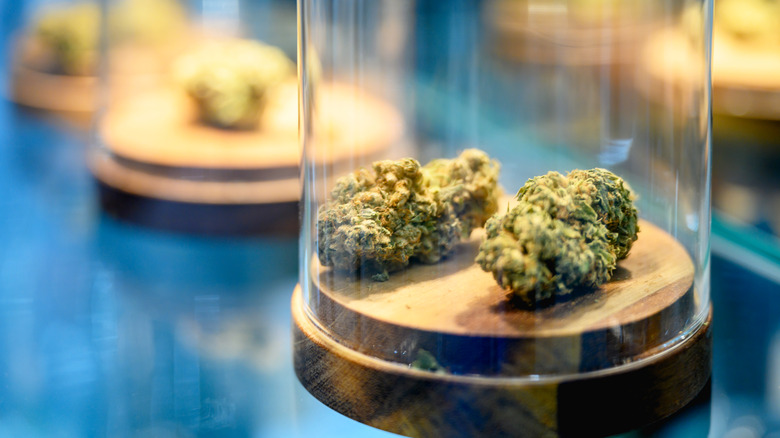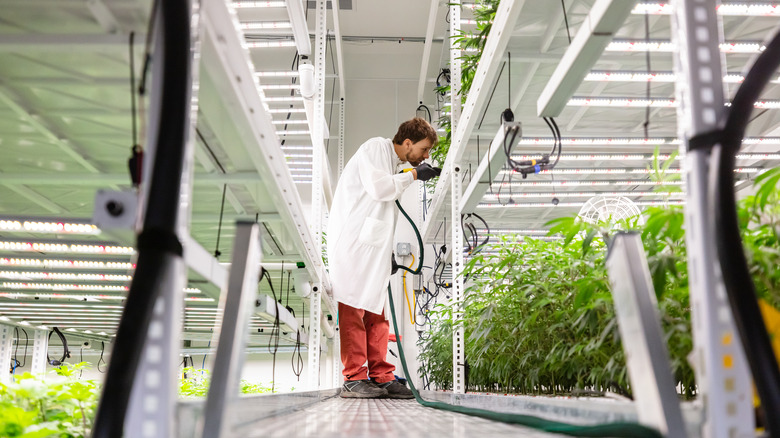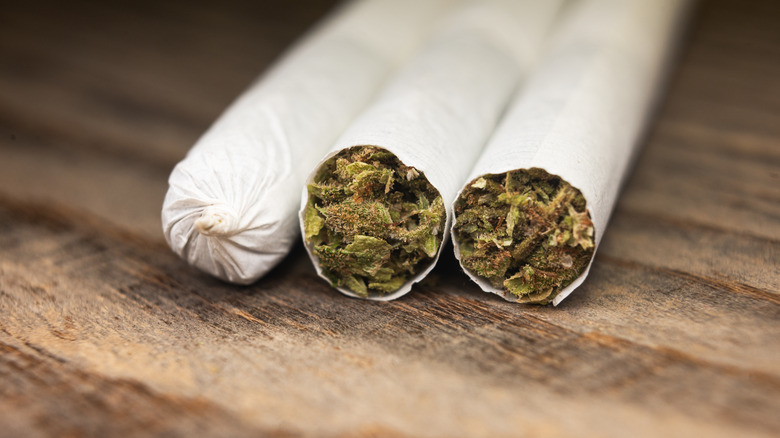Why Marijuana Is Stronger Than It Used To Be
Per the CDC, the most widely used federally prohibited drug in the United States is marijuana — though it is legal for recreational or medical use in all but four states in the nation. In 2020, 49.6 million people reported using some form of marijuana, per the Substance Abuse and Mental Health Services Administration (SAMHSA). However, aside from its popularity, the drug has been associated with an increase in potency in the past few years. Potency is linked to levels of tetrahydrocannabinol, or THC, which is responsible for marijuana's psychoactive effects. According to the Timber Cannabis Co, there are several reasons for this: an improvement in cultivation techniques, a better understanding of how the marijuana plant works, and being able to grow marijuana in controlled environments rather than having to illegally import it.
Speaking to NPR, Staci Gruber — director of the Marijuana Investigations for Neuroscientific Discovery (MIND) program — pointed to studies suggesting an over 300% increase in THC content from 1995 to 2017. Elsewhere, a 2018 paper published at the National Library of Medicine about the potency of marijuana in Colorado revealed that between 1995 and 2015, there was a huge 212% jump in THC content found in cannabis flowers. Additionally, some products that contain THC, such as edibles and oil, can contain upwards of 95% THC despite there being no research to support this amount being beneficial for medical purposes. Basically, most marijuana bought nowadays will give you much more of a "high" than marijuana bought in the 1970s or even the 1990s would. As Jamie says in "Totally Killer" after eating "like five" weed brownies, "Man, '80s weed sucks."
Marijuana isn't imported as much
The history of marijuana and how it became stronger over time goes way back. As reported by the Timber Cannabis Co, data from the Natural Center for Natural Products Research found that marijuana available today is on average 57% to 67% stronger than samples taken from the 1970s. This could partly be because cannabis no longer needs to be imported as much.
In the 1970s, marijuana was illegally smuggled in from countries like Colombia. Along the journey, the flowers would dry out due to being compressed into cannabis bricks, which made it easier to transport large amounts. Factors like light and heat reduced the potency of the plant within these marijuana bricks, meaning that what most people ended up smoking contained less THC to actually give you a "high." (Unless you're Andrew Clark in "The Breakfast Club," and smoking weed makes you inexplicably dance).
Cannabis cultivation has improved
Marijuana cultivation techniques are as advanced than ever, and we know a lot more about how to get the best out of the marijuana flower (per High Times). From the '80s onwards, hydroponic growing systems expanded in popularity, and growers started choosing strains with the highest potency — think the eponymous strain from "Pineapple Express" — while staying continually focused on growing the most potent species of the cannabis plant, sinsemilla. According to Timber Cannabis Co, sinsemilla (which simply means the flower does not produce seeds) is the most commonly dispensary-grown plant and has the highest levels of THC. In contrast, people in the past bought unregulated bags of marijuana that had been grown outdoors and shipped long distances and included the compressed stems, seeds, and leaves, along with the flower.
A report from the University of New South Wales' National Drug and Alcohol Research Centre underscored that many experts have attributed hydroponic weed growth to Australia's purported increase in marijuana THC levels (though it concluded that the data is not conclusive enough to determine if this is true). Regardless, over the decades and due to many states passing laws to legalize marijuana, the production process continues to evolve.
More people have marijuana addiction issues
As cannabis gets stronger, so does the risk of addiction because of the higher levels of THC. Per the University of Bath, Dr. Tom Freeman, director of the Addiction and Mental Health Group at the university, shared, "As the strength of cannabis has increased, so too has the number of people entering treatment for cannabis use problems. More Europeans are now entering drug treatment because of cannabis than heroin or cocaine."
"Traditionally, cannabis resin contained much lower amounts of THC with equal quantities of CBD, however CBD concentrations have remained stable as THC has risen substantially, meaning it is now much more harmful than it was many years ago," said Sam Craft, also from the university's Addiction and Mental Health Group.
Though cannabis does not carry the same risks as drugs like cocaine, SAMHSA says it can still have side effects like stunting IQ growth and affecting athletic performance. Because of this, it's always important to check the source of your marijuana so you can get information like the level of THC before you smoke or ingest the product.
If you or anyone you know needs help with addiction issues, help is available. Visit the Substance Abuse and Mental Health Services Administration website or contact SAMHSA's National Helpline at 1-800-662-HELP (4357).



